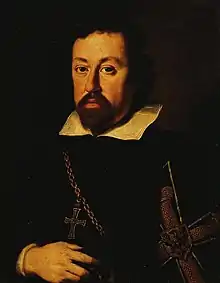Charles of Austria | |
|---|---|
| Prince-Bishop of Breslau | |
 Portrait by Justus Sustermans | |
| Native name | Karl von Österreich |
| Diocese | Roman Catholic Diocese of Breslau |
| Appointed | 1608 |
| Term ended | 1624 |
| Predecessor | Johann VI of Sitsch |
| Successor | Karol Ferdynand Vasa |
| Other post(s) | Prince-Bishop of Brixen Grand Master of the Teutonic Order |
| Personal details | |
| Born | August 7, 1590 |
| Died | December 28, 1624 (aged 34) Madrid, Spain |
| Buried | El Escorial |
| Denomination | Roman Catholic |
| Residence | Neisse (Nysa) |
| Parents | Charles II, Archduke of Austria Maria Anna of Bavaria |
Charles of Austria (German: Karl von Österreich; 7 August 1590 – 28 December 1624), nicknamed the Posthumous, a member of the Imperial House of Habsburg, was Prince-Bishop of Breslau (Wrocław) from 1608, Prince-Bishop of Brixen from 1613, and Grand Master of the Teutonic Order from 1618 until his death. In 1621 he also received the Bohemian County of Kladsko as a fief from the hands of his brother, Emperor Ferdinand II.
Life
Born in Graz, Styria, Charles was the youngest son of Archduke Charles II of Austria (1540–1590), ruling over the Inner Austrian estates of the Habsburg monarchy, and his consort Maria Anna (1551–1608), daughter of the Wittelsbach duke Albert V of Bavaria. Born less than a month after his father's death, he was nicknamed "Charles the Posthumous" (Karl der Posthume). As the last of 15 siblings, Charles, like his brother Leopold V was destined for an ecclesiastical career.
In 1602 he was appointed to a canonry of Salzburg Cathedral and in 1605 to a canonry of Passau. Further canonries in Trent and Brixen followed in 1606, and in Cologne Cathedral in 1618. These were for the most part absentee appointments that provided him with an income from ecclesiastical revenues. On 7 July 1608, at the age of 17, he was elected Prince-bishop at Breslau; he entered the city on December 14. In 1613 Charles also became Prince-Bishop of Brixen, however, he left the governance of the diocese to an administrator as he had chosen Neisse (Nysa) for his permanent residence. He did not receive holy orders until 1615, due to his young age. In 1619 he succeeded his cousin Archduke Maximilian III of Austria as Grand Master (Hochmeister) of the Teutonic Knights.[1]
Charles was a staunch Catholic. Upon his appointment as Breslau prince-bishop, he strongly protested against the 1609 Letter of Majesty, issued by his cousin Emperor Rudolf II to treat all religions equally in the Bohemian crown land of Silesia, and failed to succeed as a Silesian Landeshauptmann governor. When after the outbreak of the Thirty Years' War in 1618 the Protestant Silesian estates rebelled and acknowledged Frederick V of the Palatinate as king, the prince-bishop fled to the Polish court of King Sigismund III Vasa and later moved to Brixen. After the 1620 Battle of White Mountain he returned to forcefully reintroduce Catholicism in his Duchy of Nysa. He founded a Jesuit college Carolinum(Nysa) there in 1622. After he had received the Bohemian County of Kladsko from Emperor Ferdinand II in 1621, he had the area likewise occupied by Imperial troops and forcefully reverted to Catholicism.
In 1624 he travelled to Madrid, at the request of his nephew King Philip IV of Spain, who planned to appoint him Viceroy of Portugal. However, he fell seriously ill and died in late December before taking up his post. His mortal remains were buried in the Royal Site of San Lorenzo de El Escorial, while his heart was transferred to the newly erected St Mary's Jesuit Church in Nysa.
Ancestors
Male-line family tree
| Habsburg | |||||||||||||||||||||||||||||||||||||||||||||||||||||||||||||||||||||||||||||||||||||||||||||||||||||||||||||||||||||||||||||||||||||||||||||||||||||||||||||||||||||||||||||||||||||||||||||||||||||||||||||||||||||||||||||||||||||||||||||||||||||||||||||||||||||||||||||||||||||||||||||||||||||||||||||||||||||||||||||||||||||||||||||||||||||||||||||||||||||||||||||||||||||||||||||||||||||||||||||||||||||||||||||||||||||||||||||||||||||||||||||||||||||||||||||||||||||||||||||||||||||||||||||||||||||||||||||||||||||||||||||||||||||||||||||||||||||||||||||||||||||||||||||||||||||||||||||||||||||||||||||||||||||||||||||||||||||||||||||||||||||||||||||||||||||||||||||||||||||||||||||||||||||||||||||||||||||||||||||||||||||||||||||||||||||||||||||||||||||||||||||||||||||||||||||||||||||||||||||||||||||||||||||||||||||||||||||||||||||||||||||||||||||||||||||||||||||||||||||||||||||||||||||||||||||||||||||||||||||||||||||||||||||||||||||||||||||||||||||||||||||||||||||||||||||||||||||||||||||||
|---|---|---|---|---|---|---|---|---|---|---|---|---|---|---|---|---|---|---|---|---|---|---|---|---|---|---|---|---|---|---|---|---|---|---|---|---|---|---|---|---|---|---|---|---|---|---|---|---|---|---|---|---|---|---|---|---|---|---|---|---|---|---|---|---|---|---|---|---|---|---|---|---|---|---|---|---|---|---|---|---|---|---|---|---|---|---|---|---|---|---|---|---|---|---|---|---|---|---|---|---|---|---|---|---|---|---|---|---|---|---|---|---|---|---|---|---|---|---|---|---|---|---|---|---|---|---|---|---|---|---|---|---|---|---|---|---|---|---|---|---|---|---|---|---|---|---|---|---|---|---|---|---|---|---|---|---|---|---|---|---|---|---|---|---|---|---|---|---|---|---|---|---|---|---|---|---|---|---|---|---|---|---|---|---|---|---|---|---|---|---|---|---|---|---|---|---|---|---|---|---|---|---|---|---|---|---|---|---|---|---|---|---|---|---|---|---|---|---|---|---|---|---|---|---|---|---|---|---|---|---|---|---|---|---|---|---|---|---|---|---|---|---|---|---|---|---|---|---|---|---|---|---|---|---|---|---|---|---|---|---|---|---|---|---|---|---|---|---|---|---|---|---|---|---|---|---|---|---|---|---|---|---|---|---|---|---|---|---|---|---|---|---|---|---|---|---|---|---|---|---|---|---|---|---|---|---|---|---|---|---|---|---|---|---|---|---|---|---|---|---|---|---|---|---|---|---|---|---|---|---|---|---|---|---|---|---|---|---|---|---|---|---|---|---|---|---|---|---|---|---|---|---|---|---|---|---|---|---|---|---|---|---|---|---|---|---|---|---|---|---|---|---|---|---|---|---|---|---|---|---|---|---|---|---|---|---|---|---|---|---|---|---|---|---|---|---|---|---|---|---|---|---|---|---|---|---|---|---|---|---|---|---|---|---|---|---|---|---|---|---|---|---|---|---|---|---|---|---|---|---|---|---|---|---|---|---|---|---|---|---|---|---|---|---|---|---|---|---|---|---|---|---|---|---|---|---|---|---|---|---|---|---|---|---|---|---|---|---|---|---|---|---|---|---|---|---|---|---|---|---|---|---|---|---|---|---|---|---|---|---|---|---|---|---|---|---|---|---|---|---|---|---|---|---|---|---|---|---|---|---|---|---|---|---|---|---|---|---|---|---|---|---|---|---|---|---|---|---|---|---|---|---|---|---|---|---|---|---|---|---|---|---|---|---|---|---|---|---|---|---|---|---|---|---|---|---|---|---|---|---|---|---|---|---|---|---|---|---|---|---|---|---|---|---|---|---|---|---|---|---|---|---|---|---|---|---|---|---|---|---|---|---|---|---|---|---|---|---|---|---|---|---|---|---|---|---|---|---|---|---|---|---|---|---|---|---|---|---|---|---|---|---|---|---|---|---|---|---|---|---|---|---|---|---|---|---|---|---|---|---|---|---|---|---|---|---|---|---|---|---|---|---|---|---|---|---|---|---|---|---|---|---|---|---|---|---|---|---|---|---|---|---|---|---|---|---|---|---|---|---|---|---|---|---|---|---|---|---|---|---|---|---|---|---|---|---|---|---|---|---|---|---|---|---|---|---|---|---|---|---|---|---|---|---|---|---|---|---|---|---|---|---|---|---|---|---|---|---|---|---|---|---|---|---|---|---|---|---|---|---|---|---|---|---|---|---|---|---|---|---|---|---|---|---|---|---|---|---|---|---|---|---|---|---|---|---|---|---|---|---|---|---|---|---|---|---|---|---|---|---|---|---|---|---|---|---|---|---|---|---|---|---|---|---|---|---|---|---|---|---|---|---|---|---|---|---|---|---|---|---|---|---|---|---|---|---|---|---|---|---|---|---|---|---|---|---|---|---|---|---|---|---|---|---|---|---|---|---|---|---|---|---|---|---|---|---|---|---|---|---|---|---|---|---|---|---|---|---|---|---|---|---|---|---|---|---|---|---|---|---|---|---|---|---|---|---|---|---|---|---|---|---|---|---|---|---|---|---|---|---|---|---|---|---|---|---|---|---|---|---|---|---|---|---|---|---|---|---|---|---|---|---|---|---|---|---|---|---|---|---|---|---|---|---|---|---|---|---|---|---|---|---|---|---|---|---|---|---|---|---|---|---|---|---|---|---|---|---|---|---|---|---|---|---|---|---|---|---|---|---|---|---|---|---|---|---|---|---|---|---|---|---|---|---|---|---|---|---|---|---|---|---|---|---|---|---|---|---|---|---|---|---|---|---|---|---|---|---|---|
| [n 1] Original line / Albertinian line / Leopoldian line Max and Philip line / Spanish / Iberian line / Austrian / HRE line
| |||||||||||||||||||||||||||||||||||||||||||||||||||||||||||||||||||||||||||||||||||||||||||||||||||||||||||||||||||||||||||||||||||||||||||||||||||||||||||||||||||||||||||||||||||||||||||||||||||||||||||||||||||||||||||||||||||||||||||||||||||||||||||||||||||||||||||||||||||||||||||||||||||||||||||||||||||||||||||||||||||||||||||||||||||||||||||||||||||||||||||||||||||||||||||||||||||||||||||||||||||||||||||||||||||||||||||||||||||||||||||||||||||||||||||||||||||||||||||||||||||||||||||||||||||||||||||||||||||||||||||||||||||||||||||||||||||||||||||||||||||||||||||||||||||||||||||||||||||||||||||||||||||||||||||||||||||||||||||||||||||||||||||||||||||||||||||||||||||||||||||||||||||||||||||||||||||||||||||||||||||||||||||||||||||||||||||||||||||||||||||||||||||||||||||||||||||||||||||||||||||||||||||||||||||||||||||||||||||||||||||||||||||||||||||||||||||||||||||||||||||||||||||||||||||||||||||||||||||||||||||||||||||||||||||||||||||||||||||||||||||||||||||||||||||||||||||||||||||||||
Notes:
| |||||||||||||||||||||||||||||||||||||||||||||||||||||||||||||||||||||||||||||||||||||||||||||||||||||||||||||||||||||||||||||||||||||||||||||||||||||||||||||||||||||||||||||||||||||||||||||||||||||||||||||||||||||||||||||||||||||||||||||||||||||||||||||||||||||||||||||||||||||||||||||||||||||||||||||||||||||||||||||||||||||||||||||||||||||||||||||||||||||||||||||||||||||||||||||||||||||||||||||||||||||||||||||||||||||||||||||||||||||||||||||||||||||||||||||||||||||||||||||||||||||||||||||||||||||||||||||||||||||||||||||||||||||||||||||||||||||||||||||||||||||||||||||||||||||||||||||||||||||||||||||||||||||||||||||||||||||||||||||||||||||||||||||||||||||||||||||||||||||||||||||||||||||||||||||||||||||||||||||||||||||||||||||||||||||||||||||||||||||||||||||||||||||||||||||||||||||||||||||||||||||||||||||||||||||||||||||||||||||||||||||||||||||||||||||||||||||||||||||||||||||||||||||||||||||||||||||||||||||||||||||||||||||||||||||||||||||||||||||||||||||||||||||||||||||||||||||||||||||||
References
- ↑ Matthias Schnettger, "Karl [III.], Erzherzog von Österreich", in Biographisch-Bibliographisches Kirchenlexikon, vol. 17 (Bautz, Herzberg 2000), pp. 759–762.
- 1 2 Philip I, King of Castile at the Encyclopædia Britannica
- ↑ Ferdinand I, Holy Roman Emperor at the Encyclopædia Britannica
- 1 2 Charles V, Holy Roman Emperor at the Encyclopædia Britannica
- 1 2 Wurzbach, Constantin von, ed. (1860). . Biographisches Lexikon des Kaiserthums Oesterreich [Biographical Encyclopedia of the Austrian Empire] (in German). Vol. 6. p. 352 – via Wikisource.
- 1 2 Chisholm, Hugh, ed. (1911). . Encyclopædia Britannica. Vol. 15 (11th ed.). Cambridge University Press.
- 1 2 Casimir IV, King of Poland at the Encyclopædia Britannica
- 1 2 Obermayer-Marnach, Eva (1953), "Anna Jagjello", Neue Deutsche Biographie (in German), vol. 1, Berlin: Duncker & Humblot, p. 299; (full text online)
- 1 2 Revue de l'Agenais (in French). Vol. 4. Société des sciences, lettres et arts d'Agen. 1877. p. 497.
- 1 2 Riezler, Sigmund Ritter von (1897), "Wilhelm IV.", Allgemeine Deutsche Biographie (in German), vol. 42, Leipzig: Duncker & Humblot, pp. 705–717
- 1 2 Goetz, Walter (1953), "Albrecht V.", Neue Deutsche Biographie (in German), vol. 1, Berlin: Duncker & Humblot, pp. 158–160; (full text online)
- 1 2 Wurzbach, Constantin von, ed. (1861). . Biographisches Lexikon des Kaiserthums Oesterreich [Biographical Encyclopedia of the Austrian Empire] (in German). Vol. 7. p. 20 – via Wikisource.
- 1 2 Brüning, Rainer (2001), "Philipp I.", Neue Deutsche Biographie (in German), vol. 20, Berlin: Duncker & Humblot, p. 372; (full text online)
- 1 2 Wurzbach, Constantin von, ed. (1860). . Biographisches Lexikon des Kaiserthums Oesterreich [Biographical Encyclopedia of the Austrian Empire] (in German). Vol. 6. p. 151 – via Wikisource.